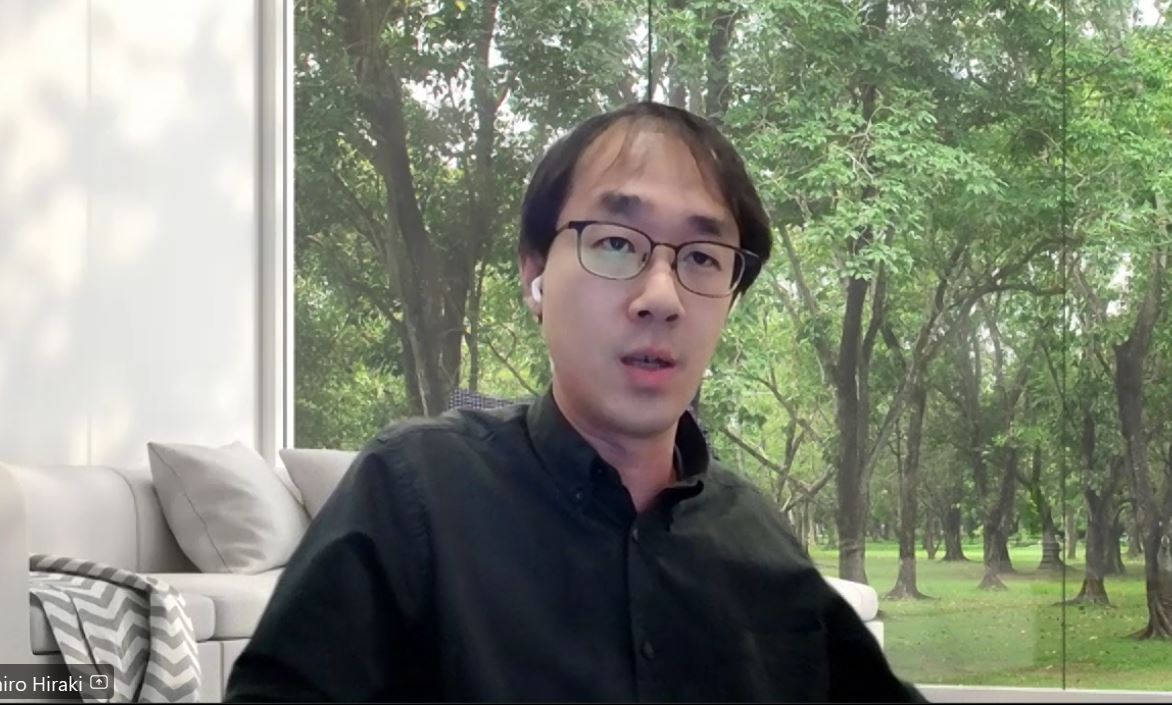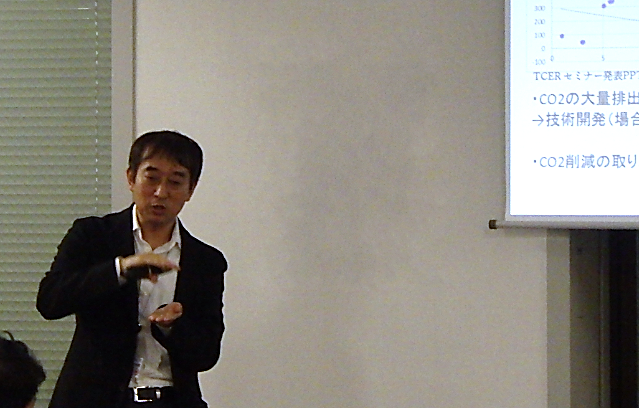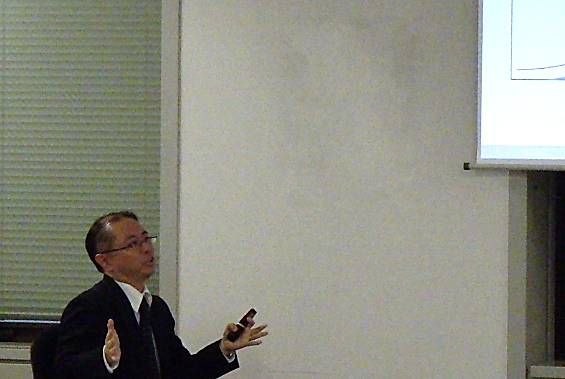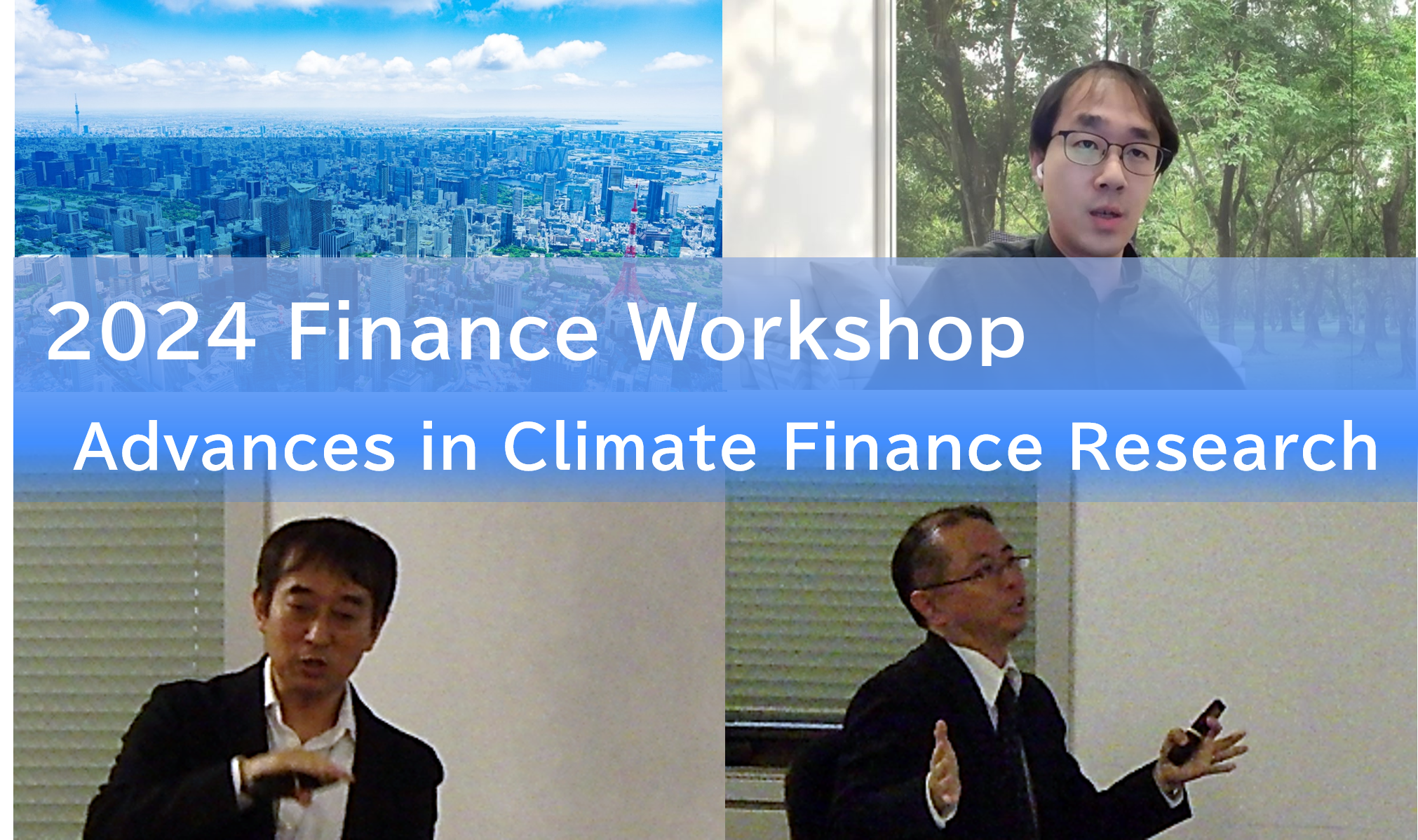To prev. page
The Institute for Monetary and Economic Studies (IMES) of the Bank of Japan (BOJ) held the Finance Workshop on November 8, 2024, in a hybrid format. In this 10th edition of the workshop, three research presentations were given under the theme of "Advances in Climate Finance Research."
- 1. Opening Remarks
- 2. Research Presentation on the Survey of Climate Finance Research
- 3. Research Presentation on Credit Default Swaps and Corporate Carbon Emissions in Japanese Firms
- 4. Research Presentation on Scenario Construction for Analyzing Climate-Related Risks
- 5. Closing Remarks
- 【References】
1. Opening Remarks
Kenji Suwazono (Executive Director, BOJ) explained that the Bank had made efforts on climate change consistent with its mandate of achieving price stability and ensuring the stability of the financial system, while actively communicating with financial institutions and engaging in international discussions. He also introduced that the IMES was continuing its efforts on climate change from a research perspective by publishing research papers in the fields of economics, finance, law, and accounting. He stated that research had been rapidly advancing from various perspectives with the recent development of data utilization and analytical methods, especially in the field of finance, and concluded his opening remarks by expressing his hope that lively discussions would be generated at the workshop.
2. Research Presentation on the Survey of Climate Finance Research

Kazuhiro Hiraki (International Monetary Fund) summarized recent developments in climate finance research, which has seen rapid progress in recent years, from the perspective of the price discovery and risk transfer functions of financial markets and the perspective of the functioning of financial intermediation.
He first reviewed the literature examining whether climate-related risks are adequately reflected in financial asset prices under the sound functioning of financial markets in terms of price discovery and risk transfer. As an example, he mentioned Bolton and Kacperczyk [2023] (Reference 1), which compares the stock returns of "green companies" with low carbon emissions and those of "brown companies" with high carbon emissions. He explained that the empirical evidence they reported suggested that brown stocks had higher returns than green stocks and that the transition risk, one of the climate-related risks, was factored into stock prices. However, he added that some recent empirical studies reported that green stocks had higher returns. While these conflicting results are difficult to interpret, he argued that we might be currently in a transitional period in which mispricing, in the sense that climate-related risks are not adequately taken into account, is being corrected.
He then pointed out the importance of the functioning of financial intermediation in financial markets, because managing climate change requires a large amount of funds, and he noted that sustainable investment had been increasing in recent years. He then overviewed the literature that analyzes the impact of sustainable investment on asset prices and the behavior of issuing companies. He reported that many previous studies had pointed out that, in order for sustainable investment to effectively expedite action toward climate change, it would be desirable to select investee companies with a focus on future emission reduction rather than current carbon emissions. He pointed out challenges going forward, including the enhancement in the quality and coverage of climate-related data, such as ESG scores, which would be indispensable in helping investors make more informed investment decisions and in increasing the effectiveness of sustainable investment.
The discussant, Professor Junnosuke Shino (Waseda University), pointed out that providing theoretical work that is useful for evaluating the results of many empirical analyses was an important contribution of this research, in addition to surveying empirical analyses on climate finance. In particular, he praised the systematic explanation of how different investor types, such as whether they use ESG scores for selecting investee companies or find non-monetary utility in the ESG scores by themselves, affect financial asset prices, using the CAPM (Pedersen, Fitzgibbons, and Pomorski [2021], Reference 2), which takes ESG investments into account. He argued that this ESG-adjusted CAPM framework helped interpret the results of conflicting empirical analyses because different types of investors may prefer green stocks or brown stocks.
3. Research Presentation on Credit Default Swaps and Corporate Carbon Emissions in Japanese Firms

Professor Tatsuyoshi Okimoto (Keio University) outlined the rapid expansion of global ESG investment over the past 15 years and pointed out the importance of understanding how financial markets have reflected corporate carbon emissions in financial asset prices. He then presented an empirical analysis of market evaluations of carbon emissions, focusing on credit default swaps (CDS) (joint work with Professor Sumiko Takaoka (Seikei University)).
He stated that if market participants view carbon emissions as the other side of the same coin of active corporate activity, then a negative relationship would be observed between carbon emissions and CDS spreads that capture corporate risk. On the other hand, if market participants view carbon emissions as the cost of future regulatory compliance (carbon risk premiums), a positive relationship between carbon emissions and CDS spreads would be observed. He then analyzed the existence of carbon risk premiums and their changes over time using data from the Japanese CDS market from 2005 to 2019.
Based on the empirical results, he pointed out that prior to 2006, when the Principles for Responsible Investment were proposed by the United Nations among others, no significant carbon risk premium was identified, and a negative relationship existed between carbon emissions and CDS spreads. He noted that over the years, however, as investors had become more aware of ESG issues, the premiums had become visible and greater. He also pointed out that the size of the premiums depended on the sector, and, in particular, the premium was smaller for those sectors in which reducing emissions is considered to be relatively difficult. Finally, as a policy implication, he argued that it might be important to utilize subsidies for introducing emission abatement technologies in sectors that face difficulties in reducing emissions, since financial market evaluations may not provide sufficient incentive for these sectors to reduce emissions, as an increase in emissions does not necessarily lead to a widening in CDS spreads.
The discussant, Professor Yoko Shirasu (Aoyama Gakuin University), praised the study as a valuable work providing rich empirical analyses, including various robustness checks, using time-series data on CDS spreads of Japanese firms and a credible climate-related database. She pointed out that it would be beneficial to deepen the analysis further, focusing on the possibility of changes in investor behavior following the adoption of the Paris Agreement in 2015, and on differences in how emissions are reduced, such as business downsizing and technology development, differences between countries and regions in investment methodologies, such as divestment and engagement, and differences in environmental strategies even among investors who have adopted the Principles for Responsible Investment.
Next : 4. Research Presentation on Scenario Construction for Analyzing Climate-Related Risks
4. Research Presentation on Scenario Construction for Analyzing Climate-Related Risks

Azusa Takeyama (Director, BOJ) first noted that financial authorities and financial institutions were giving increasing attention to the impact of climate change and its countermeasures on the financial system and financial institutions. He pointed out that the absence of appropriate reference cases and historical data was a major challenge in assessing the impact of these developments. He argued that, even under these circumstances, scenario analyses could serve as an effective tool for measuring and managing risk, and he added that scenario analyses had been conducted in more than 60 countries and regions in recent years, including Japan.
He emphasized that the purpose of this study was to organize the issues and future challenges related to scenario analyses by discussing the models used to construct scenarios, and he explained the study's main models and their characteristics (joint work with Yui Matsui (International Monetary Fund) and Takaaki Minamii (BOJ)).
He gave an example of the DICE model proposed by William D. Nordhaus (2018 Nobel Laureate in Economics, Reference 3). He explained that the model was constructed by incorporating into the standard economic growth model the mechanisms through which greenhouse gas emissions from economic activities raise the global temperature and have a negative impact on economic activities, thereby enabling the analysis of the relationship between climate change and economic growth. He pointed out that the main results of such a simple model could however change significantly, depending on key parameter values.
In light of these issues, he said that international organizations, among others, used the extended models that incorporate energy and land use conditions when constructing scenarios. He pointed out, however, that even in such extended models, smooth supply-demand adjustment through market mechanisms was assumed, and the scenarios constructed by the models were treated as a kind of baseline scenario with no frictions or shocks, which would otherwise impede economic growth. He also pointed out that, as a future challenge, it is important to expand the variation of scenarios, taking into account the economic environment and industrial structure of each country, in order to appropriately measure and manage climate-related risks that involve a high degree of uncertainty.
The discussant, Yoshiyuki Suimon (Executive Director, Nomura Securities Co., Ltd.), commended the study for elucidating the structures of the models used in constructing scenarios and the issues involved in the constructed scenarios. He then pointed out that it will become more important to improve the transparency of the models and take into account the consistency of assumptions and the interaction of economic activities in each country and region. In addition, he raised issues regarding the implications for how monetary and economic policies should be conducted in light of the issues involved in the scenario analyses.
5. Closing Remarks
Shingo Watanabe (Director-General, IMES) reviewed the research presentations, noting that climate finance research had been making rapid progress in recent years, and that there had been an increase in studies contributing to the decarbonization trend. On the other hand, he pointed out that many issues remained to be addressed, including mispricing in financial markets, methodologies and assumptions for measuring climate-related risks, and the development of climate-related databases, as discussed in the presentations, and that there remained considerable room for further efforts.
He pointed out that even in Europe, despite its reputation for leading decarbonization efforts, there had been recent signs of a weakening of climate policies, as seen for example in the postponement of regulations on gasoline and diesel vehicles and oil and gas heating in the United Kingdom. He noted that these developments indicated that while the long-term trend toward decarbonization would remain the same, the actual transition would not be straightforward. He concluded his remarks by stressing the importance for academics, practitioners, and policy makers not to pause in the face of this reality, but to continue to conduct research and discussions that will contribute to the decarbonization trend from their respective standpoints.
The affiliations and titles listed here are as of the time of this workshop.
【References】
Click on the number at the end of the document to return to the main text.
- Bolton, Patrick, and Marcin Kacperczyk, “Global Pricing of Carbon-Transition Risk, ”Journal of Finance, 78(6), 2023, pp.3677-3754. (1)
- Pedersen, Lasse H., Shaun Fitzgibbons, and Lukasz Pomorski, “Responsible Investing: The ESG-Efficient Frontier, "Journal of Financial Economics, 142(2), 2021, pp.572-597. (2)
- Barrage, Lint, and William Nordhaus, “Policies, Projections, and the Social Cost of Carbon: Results from the DICE-2023 Model, ”Proceedings of the National Academy of Sciences of the United States of America, 121(13), 2024, e2312030121.(3)
